Repurpose kitchen items for safe lye crafting with stainless steel stockpots that withstand high temperatures, silicone baking molds for creative soap shapes, and glass containers for ingredient storage. Don't use glass for lye mixing, but Pyrex bowls work well for soap batter. Wooden bread boxes create perfect curing chambers, while ice cube trays make ideal testing molds. Grab your rubber gloves and goggles – these seven kitchen tools will transform your crafting experience.
7 Clever Kitchen Items For Your Lye Crafts
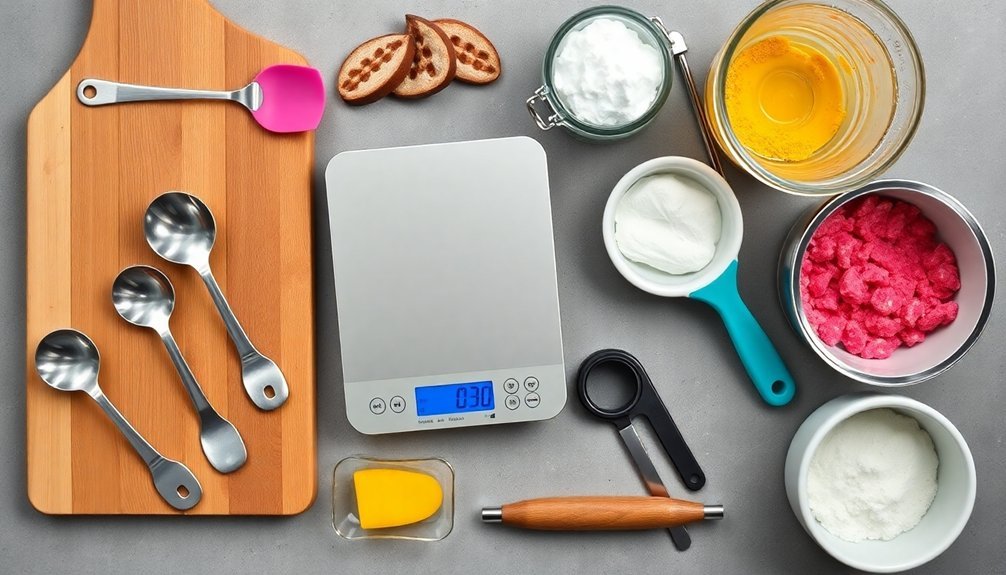
While you might think of lye crafts as requiring specialized equipment, many items already in your kitchen can be repurposed for these projects. Glass containers from hydrogen peroxide make excellent vessels for handling chemicals due to their non-reactive nature. Silicone or stainless steel spatulas are perfect for stirring lye mixtures safely.
Look around your kitchen—everyday items like glass bottles and metal utensils make perfect, budget-friendly tools for lye crafting.
When organizing your workspace, transform old kitchen pans into catchalls or use glass canisters to store ingredients securely. For actual soap making, your immersion blender or stick blender will quickly mix lye and oils to the perfect consistency. You can add style to your crafting space with vintage cookie cutters displayed in a nice frame on your wall while keeping essentials within reach.
Remember that safety comes first! Keep rubber gloves, protective goggles, and paper towels handy. Always have vinegar nearby as a neutralizing agent for any accidental spills.
With these kitchen essentials, you'll craft with confidence.
Stainless Steel Stockpots: Perfect Lye-Safe Mixing Vessels
The humble stainless steel stockpot might be your most valuable ally in lye-based crafting. Unlike aluminum or copper which react dangerously with lye, stainless steel remains completely non-reactive, making it ideal for mixing your solutions safely.
You'll appreciate its durability when handling the heat generated during the lye-water reaction. When planning your workspace, ensure your stockpot sits on a clean surface away from food preparation areas.
- Perfect for both mixing lye solutions and heating oils in one versatile container
- Spacious enough for large soap batches, reducing the need for multiple containers
- Easy to clean thoroughly, ensuring no lye residue remains
- Can be safely used in your kitchen after proper cleaning (unlike plastic containers)
Remember to always wear protective gear and work in well-ventilated areas when using your stockpot for lye projects.
Silicone Baking Molds: Creative Shapes for Handcrafted Soaps
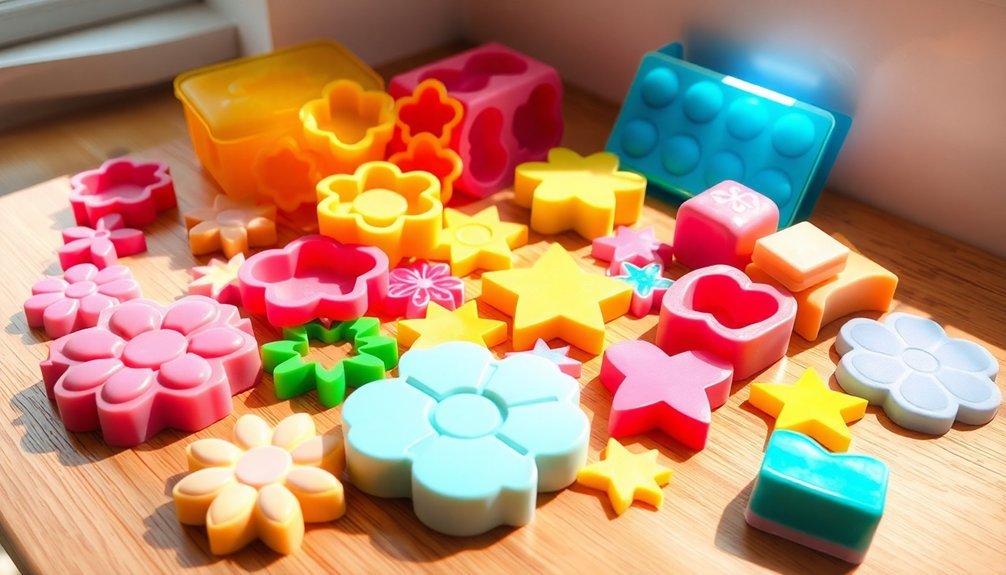
You'll love how silicone baking molds offer hassle-free unmolding thanks to their flexible material that easily releases your handcrafted soaps.
Their heat-resistant properties make them safe for hot lye mixtures and oven-warmed gelling techniques without warping or releasing toxins.
From flowers to geometric patterns, these molds reveal endless creative possibilities for intricate soap designs that will impress gift recipients and customers alike. Unlike traditional wooden molds, these non-toxic silicone options won't require prepping or lining before use, saving you valuable time in your soapmaking process.
Flexible Unmolding Process
Releasing perfectly formed soaps from their molds becomes remarkably simple when you're working with silicone baking molds. The flexible material bends easily, allowing your soap creations to pop out intact without damage to intricate details or delicate edges.
Unlike rigid molds that might require greasing or lining with paper, silicone's non-stick properties eliminate these extra steps in your soap-making process:
- Wait until your soap has completely set, then gently press around the edges to break the seal.
- Flip the mold over and apply light pressure from the back side.
- For stubborn soaps, place in the freezer for 15-30 minutes to contract the soap slightly.
- Carefully flex the sides of the mold away from the soap rather than pulling directly.
When pouring your soap mixtures, adding colorful rainbow nonpareils to the mold before pouring creates a decorative effect on the finished product.
Heat-Resistant Safety Advantage
Beyond flexibility for unmolding, silicone baking molds offer remarkable heat resistance that's particularly valuable when working with lye-based soap formulations.
These kitchen tools easily withstand the temperatures generated during cold process soap making without warping or releasing harmful chemicals.
You'll appreciate that silicone doesn't absorb or react with lye, ensuring your molds remain uncontaminated and your soap recipes pure.
This non-reactivity prevents potential chemical interactions that could compromise both your crafted soaps and the molds themselves.
With proper care, your silicone molds will serve you for years, maintaining their non-stick properties despite repeated exposure to caustic ingredients.
Their chemical compatibility extends to essential oils and colorants, allowing you to experiment freely with various soap formulations without worrying about damaging your creative vessels.
For optimal results when unmolding cold process soap, add 1 tsp. of sodium lactate per pound of oils as recommended.
Intricate Design Possibilities
When exploring the artistic dimension of soap making, silicone baking molds truly shine by offering an impressive array of intricate design possibilities.
You'll find these versatile tools allow you to create professional-looking soaps with detailed patterns that would be impossible with traditional molds.
- Nature-inspired creations: Craft beautiful floral, leaf, and organic designs that showcase your artistic vision
- Geometric precision: Create modern, clean-lined soaps with perfect angles and symmetry
- Seasonal themes: Switch between holiday-specific shapes to keep your product line fresh and relevant
- Custom expressions: Incorporate stamps or combine techniques for truly unique soaps that stand out
The flexibility of silicone guarantees your creations release cleanly without damaging delicate details, preserving every nuance of your artistic vision. Popular options like the 6 Cavity Honeycomb Silicone Mold boast 4.6 out of 5 customer satisfaction ratings, reflecting their exceptional quality.
Glass Measuring Cups: Precise Lye Solution Preparation
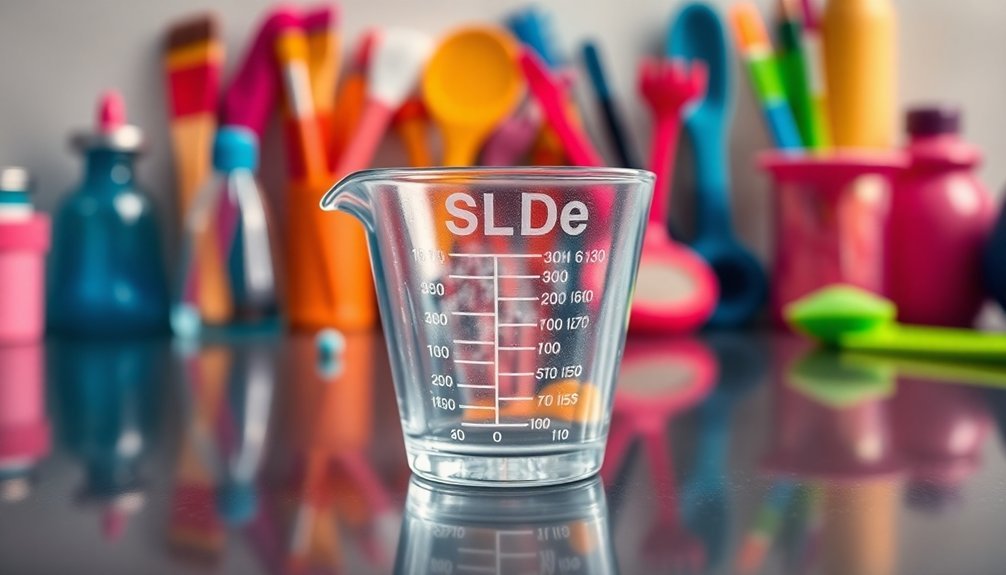
Never use glass measuring cups for lye solutions, as they can etch, weaken, and potentially shatter, even if made of Pyrex.
Instead, opt for stainless steel or polypropylene (PP#5) containers which safely withstand the extreme heat generated during lye dissolution.
Reserve your glass measuring cups for accurate measurement of other soap-making ingredients like oils, fragrances, and colorants that don't involve direct contact with lye.
The temperature of lye solutions can exceed 160 degrees Fahrenheit, creating explosion risks when using glass containers.
Accurate Volume Measurement
Although glass measuring cups provide excellent visibility for checking liquid levels, they aren't appropriate for mixing lye solutions due to potential shattering from extreme heat generation.
Instead, rely on safer alternatives that still deliver the precision you need.
For accurate volume measurements in your lye crafts:
- Use digital scales for weighing lye and oils—they provide the most precise measurements for consistent, safe soap
- Select polypropylene (PP#5) or stainless steel containers specifically for handling lye solutions
- Reserve glass measuring cups exclusively for oils and non-lye ingredients
- Calibrate your measuring tools regularly to guarantee continued accuracy
Remember that precise measurements aren't just about perfect soap—they're essential for safety when working with caustic materials. Knowing the correct SAP value of each oil in your recipe is crucial for calculating the exact amount of lye needed for proper saponification.
Heat-Resistant Material Benefits
The Accurate Volume Measurement mentioned that glass measuring cups aren't appropriate for lye solutions, which leads us to an important discussion about material selection.
When handling lye, heat-resistant materials provide critical safety advantages. Borosilicate glass measuring cups stand out as ideal tools for lye crafting. They resist thermal shock when the exothermic reaction between lye and water generates significant heat. This stability prevents cracking or shattering that could cause dangerous splashes or spills.
Beyond safety, these materials offer chemical resistance, preventing unwanted reactions with your caustic solutions. Thermosets and ceramics also exhibit high resistance to chemicals and can be excellent alternatives for lye handling. Their non-porous surfaces make cleanup simpler and more thorough.
Though initially more expensive than plastic alternatives, heat-resistant glass provides long-term value through durability and versatility – serving you reliably across multiple crafting projects while maintaining consistent performance.
Temperature Indication Features
When preparing lye solutions, accurate temperature monitoring becomes essential for both safety and crafting success. Glass measuring cups provide the perfect solution with their temperature indication capabilities that guarantee precision during your lye-based projects.
The borosilicate glass construction offers several advantages:
- Visual clarity allows you to easily monitor solution temperatures and chemical reactions as they occur.
- Temperature stability means the cup can handle rapid temperature fluctuations without cracking or shattering.
- Non-reactive surface prevents any chemical interaction that might compromise your measurements or formula.
- Etched markings remain visible and accurate even after repeated use with caustic substances.
The curved spout design ensures that you can pour your prepared lye solutions with precise control, minimizing the risk of dangerous spills.
These features combine to make glass measuring cups indispensable for safely handling lye solutions while maintaining the exact temperatures your craft requires.
Heat-Resistant Pyrex Bowls: Versatile Soap Batter Containers
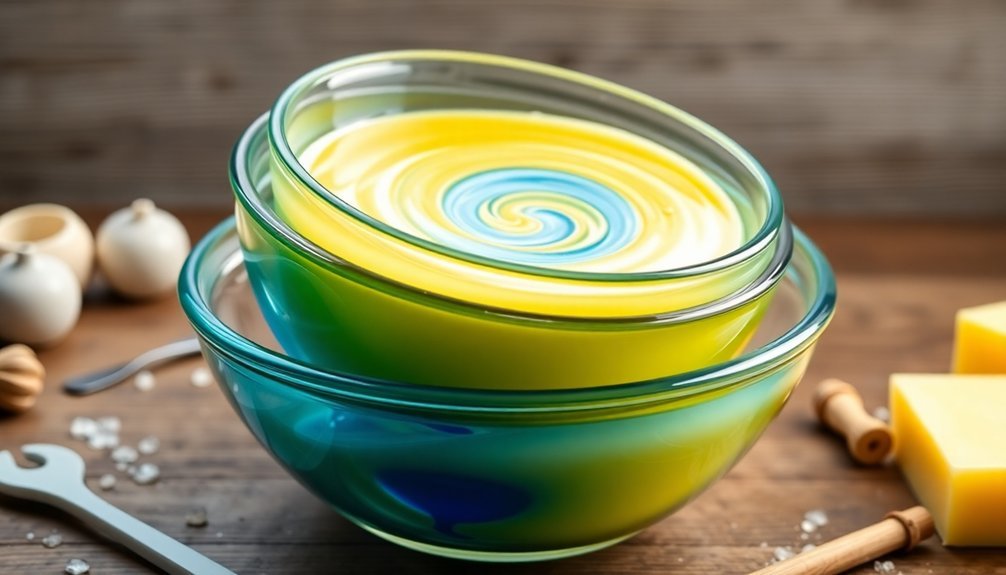
Crafting soap at home requires reliable tools that can handle both the chemical reactions and heat fluctuations involved in the process.
While Pyrex bowls aren't recommended for mixing raw lye due to potential shattering risks, they're perfect for handling soap batter after lye neutralization.
The transparent borosilicate glass allows you to monitor your mixture easily, ensuring ingredients are fully incorporated. Modern Pyrex products may actually contain tempered soda lime rather than the original borosilicate formulation used prior to 1998.
Many Pyrex bowls feature graduated measurements and pour spouts, making precise pouring into molds effortless. They're also easy to clean and sanitize between batches.
For direct lye handling, stick with stainless steel or polypropylene containers for safety.
But when your soap reaches trace and chemical reactions have stabilized, transfer your mixture to Pyrex for its visibility advantages and precise pouring capabilities.
Wooden Bread Boxes: Insulated Curing Chambers for Fresh Soaps
Ingeniously repurposed from kitchen storage to soapmaking tool, wooden bread boxes offer a surprising benefit for artisanal soap makers.
These hardwood containers provide an ideal environment for curing your freshly cut bars, maintaining appropriate humidity levels while protecting soaps from dust and direct light.
- Compact storage solution that accommodates multiple soap bars in a space roughly 15 x 9.5 x 7.5 inches
- Natural humidity regulation from wood (especially olive wood) helps soap cure evenly without excessive drying
- Adds rustic aesthetic appeal to your crafting area while serving a practical purpose
- Creates a controlled environment that prevents mold while allowing necessary airflow for proper curing
Remember to guarantee some ventilation within your bread box to prevent moisture buildup during the curing process. This method supports the 4 to 6 weeks curing time typically required for handmade soaps to properly harden and develop their best qualities.
Ice Cube Trays: Mini Molds for Sample Soaps and Testing
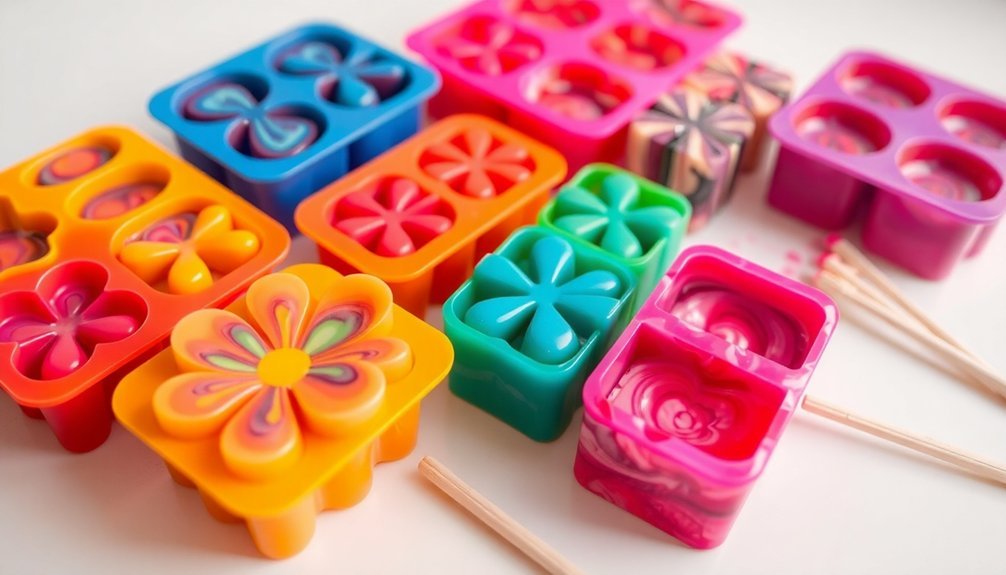
The humble ice cube tray transforms into an invaluable tool for soap makers seeking to test new recipes without committing to full-sized batches.
Small-batch testing with ice cube trays: your soap making laboratory in miniature form.
These versatile molds create perfect sample-sized soaps that allow you to experiment with different formulations before scaling up.
You'll appreciate their easy-release design when unmolding your creations and their space-saving form when working in limited crafting areas.
The trays aren't just for final products—they're excellent for freezing liquid ingredients like goat milk before adding lye, preventing discoloration and dangerous overheating.
Always wear gloves and eye protection when handling lye, and never return soap-making trays to food use.
When working with ice cube trays, ensure they're made of heavy-duty plastic as lye can damage aluminum containers.
For larger batches, consider alternatives like cottage cheese containers or ziplock bags for freezing your liquid ingredients.
Frequently Asked Questions
Can I Use Aluminum Cookware for Making Lye-Based Soap?
No, you shouldn't use aluminum cookware for lye-based soap. Lye reacts with aluminum, producing dangerous hydrogen gas that's highly flammable. Instead, choose stainless steel, glass, or heat-resistant plastic containers for safety.
How Long Should Homemade Soap Cure Before Using?
You'll need to cure your homemade soap for 4-6 weeks typically. Cold process soaps need this time to complete saponification and evaporate excess water. Specialty soaps like castile benefit from even longer curing periods.
What's the Safest Way to Dispose of Leftover Lye Solution?
You'll need to neutralize leftover lye solution with vinegar in a heat-resistant container, then dilute it with plenty of water before disposal. Always follow local hazardous waste regulations for final disposal methods.
Can Kitchen Utensils Be Used for Food After Soap Making?
Yes, you can use stainless steel utensils for food after soap making if you clean them thoroughly. However, dedicate glass items to soap making only, as repeated lye exposure causes etching. Always prioritize thorough dishwasher cleaning to prevent contamination.
How Do I Test if My Homemade Lye Is the Correct Strength?
You can test your homemade lye's strength using the egg float method. If an egg floats with a quarter-sized area above the solution, your lye is at the correct strength for soapmaking.
In Summary
Don't let specialized equipment stand in your way of lye crafting success. You'll find many soap-making tools hiding in your kitchen right now. With these seven clever repurposed items, you're ready to mix, mold, and store your handcrafted creations safely. Remember to dedicate these tools exclusively to your crafting projects once they've touched lye. Now you're all set to start creating beautiful, personalized soaps!

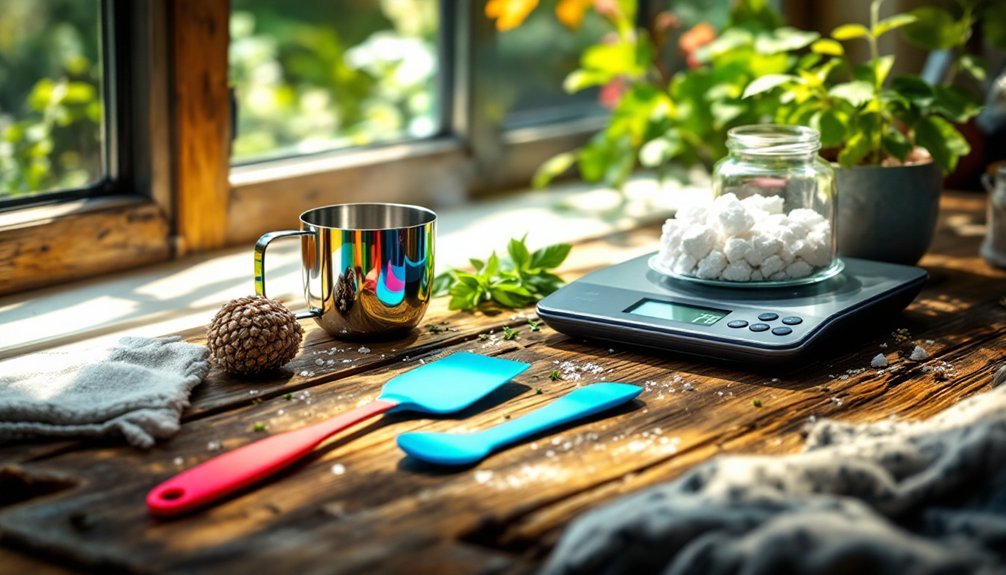



Leave a Reply